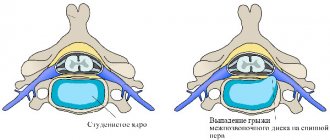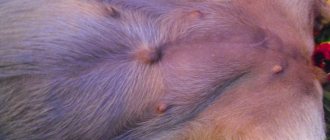Diagnosis of animal diseases is far behind human medicine. However, many people, having felt a sore throat, continue to work and do not even try to get treatment, and when they notice that their pet is unwell, they panic.
Sore throat in dogs (acute tonsillitis) is an inflammation of the pharynx, tonsils, and swallowing ring, accompanied by swelling of the mucous membranes of the respiratory tract.
Unlike people who are able to endure a sore throat “on their feet,” the animal will require care and treatment, so we will understand all the nuances in advance.
Throat diseases in dogs - hypotheses, facts, axioms
There are a number of animal diseases not recognized by veterinary practice, sore throat is one of them.
So do dogs get tonsillitis? Definitely yes! However, the concept of “canine sore throat” includes a wider range of ailments - almost all types of ailments accompanied by swelling and irritation of the mucous membranes of the respiratory tract.
Based on the complex of symptoms, angina in animals is divided into:
- Catarrhal – “classic” form.
- Croupous - complicated by severe edema, the formation of exudate that fills the intercellular space of the mucous membranes, and difficulty breathing. The development of the disease is acute and quickly develops into bronchitis or pneumonia.
- Diphtheritic - acute inflammation, accompanied by the appearance of a gray-white film and purulent foci.
- Ulcerative - the root cause of inflammation is the fusiform bacillus and Vincent's spirochete - microbes that infect the mucous membranes with the subsequent opening of ulcers. Parasites work in symbiosis and do not attack the body’s immunity, so the disease can occur without fever.
There is a hypothesis that animals can become infected from their owners with diseases such as ARVI and there are no “iron” arguments to refute this version at the moment, however, there are several nuances:
- Cold viruses that infect humans and animals have different strains.
- Many fungi, spores, and bacteria are “universal” parasites.
- The most common source of human sore throat is streptococci and staphylococci - persistent, rapidly multiplying parasites that infect animals and people.
When diagnosing human sore throat, most often, the nature of the disease is not clarified. The disease is fleeting, so the optimal solution is comprehensive treatment.
Based on the facts, the answer to the question of whether a dog can become infected with a sore throat from a person is positive, provided that the carrier is experiencing the acute phase of bacterial tonsillitis.
In what order do symptoms develop?
When examining your dog at home, rely on your intuition and your own experience with tonsillitis. Symptoms develop in the following order:
- Minor nasal discharge, sometimes foamy.
- A burning sensation, a sore throat, a foreign object in the throat - the dog coughs, tries to cough up, sticks out its tongue, and there is increased salivation.
- Upon examination, swelling and redness of the mucous membranes are noticeable, the tonsils are enlarged, sometimes “loose”, the tongue is coated.
- It hurts the dog to swallow, the animal spits out chewed food or stretches its neck, often swallows saliva, and refuses solid food.
- Body temperature rises by 1–3°C (not always); in acute cases, fever and asphyxia are observed.
- The animal refuses to eat and drink, whines, shakes its head, and tries to get its paw into its mouth.
Before treating your dog with antibiotics, provide it with rest and proper care for 12–18 hours, monitor trends, perhaps the body will cope with the disease on its own.
- Place the dog in a quiet, ventilated area.
- Set up a soft, warm bed, move the drinking bowl and feeder.
- Limit your walking time to a minimum, especially during the cold season.
- Provide your dog with warm food and drink.
- If your dog eats poorly, support the body with glucose injections.
- Warm compresses are the best method to relieve discomfort.
- Do not leave the animal unattended, encourage the dog and talk to it.
- Consult your doctor by phone in case of complications.
Source: https://vashipitomcy.ru/publ/sobaki/bolezni/angina_u_sobak_priznaki_i_lechenie_bolezni/26-1-0-800
If your dog has a sore throat, how to treat it
The reasons why a dog’s body can get a sore throat are as follows:
- Hypothermia of the animal's body. This happens if the pet is exposed to the cold for a long time, for example, in a room that is not suitable for the animal in temperature, or while eating chilled food.
- Inadequate dog care. Very often the body accepts viruses when it is weakened, that is, it lacks nutritional minerals and beneficial vitamins. Immunity is also weakened if the animal is cared for at a low level, namely, the necessary vaccinations are not given and close monitoring of the dog’s general well-being is not carried out.
- Infection by airborne droplets from other surrounding subjects. This happens if the causative agent of this disease, streptococcus, which according to its organic properties is quite tenacious and active, is transmitted through food, things and utensils.
Regardless of the reasons for contracting a sore throat, the symptoms appear the same. In order to understand that this is a sore throat, and to begin a certain course of treatment, you need to pay close attention to the manifestation of this disease.
In veterinary medicine, it is customary to divide the disease into primary and secondary. The most common causes of primary laryngitis include the following factors:
- Hypothermia of the body. Swimming in a cold open body of water, a long walk in bad weather, keeping a pet in a damp and cold room with drafts often lead to illness. Animals often get sick after water procedures in the winter season.
- Consuming cold or hot food, cold water during the hot season or after intense physical activity. Violation of the temperature regime when feeding and watering a dog leads to irritation of the mucous membrane of the larynx and its inflammation.
- Keeping a dog in a gas-filled, smoky room. Exhaust gases, construction dust, and tobacco smoke negatively affect the condition of the epithelium of the upper respiratory tract and cause its destruction.
- Unqualified probing procedure (endoscopy, bronchoscopy).
Factors predisposing to laryngitis are the animal’s weak immune system, concomitant diseases, advanced age, and an allergic reaction. In veterinary practice, there is a breed predisposition to the disease. Representatives of brachycephalic breeds, due to the peculiarities of the anatomical structure of the upper respiratory tract, are more often susceptible to laryngitis, as well as many other pathologies of the respiratory system.
When feeding the animal, especially dry food, the symptom intensifies.
- The dog lies with its neck extended. This position reduces pain and allows you to breathe normally.
- The animal is depressed, lethargic, apathetic.
- Decreased appetite or complete refusal to feed.
- On palpation, pain is detected in the larynx area. The manipulation causes a reflex cough in the dog.
- In severe cases, shortness of breath is observed. As a rule, this symptom indicates that inflammation spreads to the trachea and bronchi.
- The general body temperature with catarrhal inflammation remains within normal limits. With the development of lobar laryngitis, a dog experiences fever, muscle tremors, and cyanosis of the mucous membranes.
In some cases, owners may notice discharge from the nose and eyes, but these symptoms are not typical with laryngitis.
The symptoms of laryngeal edema in a dog are quite characteristic, and it is very difficult not to notice them. Inhalation and exhalation become very loud, the sound is wheezing and whistling. In the early stages, these signs can be missed, especially in brachycephalic dogs (bulldogs generally sniffle and grunt constantly). But the disease progresses, the animal begins to cough heavily and constantly.
Gradually, the airway obstruction progresses, making it increasingly difficult for the dog to breathe, eat and drink. Some diseases, such as degenerative polyneuropathy, can also be accompanied by problems with swallowing, regurgitation and even paralysis of all organs of the throat. So it’s not worth making a diagnosis “by eye”. If any signs resembling those described above appear, contact your veterinarian immediately.
Watch video consultations on animal diseases, feeding and maintenance on the YouTube channel “PLANET BIO”. See here...
The most common diseases are pharyngitis and tonsillitis. It is these diseases that cause sore throat in dogs.
Pharyngitis. As a rule, it rarely develops as a primary disease; Typically, this sore throat occurs simultaneously with an infection of the sinuses, mouth, ears, or respiratory tract. The following symptoms may be observed: fever, sneezing, lethargy, cough. Usually, a dog with this disease does not want to eat food and rarely drinks.
We suggest you familiarize yourself with a place for a dog: a soft, sleeping place in an apartment with your own hands, as well as how to teach it to sleep on yours
Diagnostics. A thorough visual examination reveals significant redness of the mucous membrane of the throat, and possible pus. In this case, the entire area of the larynx is swollen, it is hot and often painful.
Treatment. The use of an antibiotic is mandatory. You can warm your neck with a heating pad, or inject non-hot decoctions of chamomile and mint into your throat several times a day. Medicines will ease the dog’s suffering: Mercurius solubilis, Belladonna for difficulty swallowing, Aconite for fever. Next you should contact your veterinarian.
Tonsillitis. Your dog may experience painful inflammation of the tonsils. The disease is usually caused by an infection of the throat and respiratory system. A sick four-fingered friend experiences depression, increased body temperature, and loss of appetite.
Diagnostics. Redness and enlargement of the tonsils, frequent vomiting.
Treatment. In order to increase the effectiveness of treatment, appropriate conditions of care, maintenance and nutrition are created for the sick dog. The sick animal is moved to a warm room with bedding (if the dog was previously kept outside in an enclosure).
If several dogs are kept in the house at the same time, then all sick animals are moved to a separate room (isolator), and the previous area where they are located must be thoroughly cleaned and disinfected. Healthy dogs must be monitored in order to notice signs of illness in time.
All food for sick animals is served warm. In cases where a dog refuses to eat for a long time, in order to strengthen the animal’s body, nutritious enemas (glucose solutions, decoctions) and a 25% glucose solution are used intravenously. The patient is given heated water to drink.
When providing medicinal support, you need to rely on the degree of throat inflammation. In the absence of abscesses, warm compresses or simply wraps or bran poultices are used; Electrothermal procedures are effective - Minin lamp or Solux, UHF, diathermy. Alcohol-camphor compresses, mustard plasters, and rubbing in camphor oil are used as anti-inflammatory agents.
Dogs, like people, use inhalation of water vapor with ichthyol, turpentine, and creosote. You can give it inhalation with Lazolvan.
To directly influence the dog’s throat inflammation, weak astringents and disinfectants, ointments and solutions are injected through the nose. Ointment (iodide, salicylic, streptocidal, ichthyol) in a dose of 3-4 g is administered through the nasal cavity to the pharynx. Before administration, the ointment is heated to 35−40C.
The pharyngeal mucosa is thoroughly lubricated with a cotton swab, previously moistened with hydrogen peroxide (3%), iodine-glycerin (1:4) or borax solution (3%). Excellent results are obtained by mixtures of sulfazole, penicillin 20 thousand units and white streptocide 1 g each; tannin 1g, ephedrine 0.015g, talc 10g, milk sugar 15g and collargol 1g. The resulting mixture is applied to the pharyngeal mucosa with a spray.
In very severe forms of inflammation of the pharynx, accompanied by high body temperature, dogs are prescribed antibiotics intramuscularly in accordance with the instructions for their use.
Diagnosis of animal diseases is far behind human medicine. However, many people, having felt a sore throat, continue to work and do not even try to get treatment, and when they notice that their pet is unwell, they panic. Sore throat in dogs (acute tonsillitis) is an inflammation of the pharynx, tonsils, and swallowing ring, accompanied by swelling of the mucous membranes of the respiratory tract. Unlike people who are able to endure a sore throat “on their feet,” the animal will require care and treatment, so we will understand all the nuances in advance.
There are a number of animal diseases not recognized by veterinary practice, sore throat is one of them. So do dogs get tonsillitis? Definitely yes! However, the concept of “canine sore throat” includes a wider range of ailments - almost all types of ailments accompanied by swelling and irritation of the mucous membranes of the respiratory tract. Based on the complex of symptoms, angina in animals is divided into:
- Catarrhal – “classic” form.
- Croupous - complicated by severe edema, the formation of exudate that fills the intercellular space of the mucous membranes, and difficulty breathing. The development of the disease is acute and quickly develops into bronchitis or pneumonia.
There is a hypothesis that animals can become infected from their owners with diseases such as ARVI and there are no “iron” arguments to refute this version at the moment, however, there are several nuances:
- Cold viruses that infect humans and animals have different strains.
- Many fungi, spores, and bacteria are “universal” parasites.
Based on the facts, the answer to the question of whether a dog can become infected with a sore throat from a person is positive, provided that the carrier is experiencing the acute phase of bacterial tonsillitis.
- A burning sensation, a sore throat, a foreign object in the throat - the dog coughs, tries to cough up, sticks out its tongue, and there is increased salivation.
- Upon examination, swelling and redness of the mucous membranes are noticeable, the tonsils are enlarged, sometimes “loose”, the tongue is coated.
- Body temperature rises by 1–3°C (not always); in acute cases, fever and asphyxia are observed.
Glucose solution is administered intravenously and subcutaneously, making sure that the body is not dehydrated. Antibiotics for dogs are used in the treatment of sore throat:
- penicillin,
- streptomycin,
- enrofloxacin,
- amoxicillin,
- ciproloxacin,
- metronidazole and others.
Symptoms, methods of assistance and treatment of sore throat in an animal
Sore throat in dogs is a disease in which inflammation of the tonsils, pharyngeal ring and velum occurs.
It is often caused by hypothermia due to improper care of the dog, eating cold food, as well as infection from a sick animal, since sore throat is a very contagious disease.
Symptoms of sore throat in dogs
The animal clearly has difficulty eating and swallows cautiously and with great difficulty. When swallowing, it stretches its neck, spits out the chewed food, and the dog may refuse to eat. The dog's body temperature rises, sometimes very strongly.
One of the very first signs of a sore throat, even when the dog is eating normally and feeling quite cheerful, is foamy nasal discharge.
Already at this stage of the disease, the temperature may still be normal, but a sore throat can be determined by the fact that redness and swelling are already visible in the throat.
The dog may also constantly try to swallow. When examined, the dog's velum is always red and swollen. When palpated in the pharynx area, inflammatory swelling and soreness of the pharynx are noticeable. There is an increase in the submandibular lymph nodes, which in smooth-haired dogs can be visible from the outside with the naked eye.
Antibiotics used in the treatment of sore throat in dogs
A sick animal must be isolated from others in a separate warm room. It should be provided with soft, warm food (ground soup, liquid porridge, dry food dissolved in broth) or given rich broth. If the dog is unable to swallow, he is given nutrient enemas.
Glucose solution is administered intravenously and subcutaneously, making sure that the body is not dehydrated. Antibiotics for dogs are used in the treatment of sore throat
- penicillin,
- streptomycin,
- enrofloxacin,
- amoxicillin,
- ciproloxacin,
- metronidazole and others.
You can also give the animal sulfadimezin, norsulfazole. Warming compresses are placed locally on the pharynx area: camphor alcohol, ichthyol alcohol. You can treat the inside of the throat 2-3 times a day with Lugolia, and also spray Ingalipt frequently.
Veterinarians often prescribe Cycloferon injections. First daily for four days, and then every other day three more times. Autohemotherapy gives good results. If the dog gets sick during the cold season, walking should be greatly limited and it is better to walk in clothes and with a scarf around the neck.
Disease prevention comes down to avoiding colds and avoiding sick animals.
Source: https://dogsecrets.ru/stati/1139-angina-u-sobak.html
Diagnostics
Diagnostics at the clinic includes:
- Analysis of dog keeping conditions.
- Clinical examination of the pharynx.
- Examination of the throat using a laryngoscope, endoscope or ultrasound (as indicated) to determine the source of inflammation and its nature. The procedure requires preparation - the administration of sedatives.
- X-ray examination (if indicated).
- Serological and microbiological research methods.
- Clinical and biochemical blood tests.
Tonsillitis in dogs
Tonsillitis is an infectious disease in which the tonsils become inflamed.
Tonsils are organized lymphoid tissue located in the oral cavity and nasopharynx. The tonsils are porous in structure; during the inflammatory process, a huge number of bacteria accumulate in them, such as Escherichia coli, Staphylococcus aureus, hemolytic streptococcus and others.
Etiology
Tonsillitis is rarely seen as an underlying disease in dogs. Usually it is a consequence of inflammation in the nasal (mainly due to rhinitis) or oral cavities (common causes are tartar, gingivitis, stomatitis, neoplasms).
It can also be a consequence of chronic vomiting or regurgitation (megaesophagus), chronic cough (with bronchitis) or mechanical trauma. Chronic tonsillitis is more common in dogs with a brachiocephalic (shortened) skull structure and is associated with anatomical changes in the soft palate.
The frequency of occurrence is higher in toy breeds than in large dogs.
Clinical manifestations and diagnosis
Tonsillitis is not always accompanied by obvious clinical signs. Increased temperature and lethargy are quite rare and only due to a systemic process. When you cough, a small amount of mucus may come out. Lack of appetite, lethargy, drooling and dysphagia are observed only during severe sore throat.
With severe inflammation, swelling of the tonsils can be quite pronounced and leads to the development of dysphagia and respiratory stridor (characteristic wheezing when inhaling).
Tonsillitis is usually the result of general or regional inflammation, but some tumors can look similar to inflammation of the tonsils, so first of all it is worth ruling out such dangerous tumors as lymphosarcoma, squamous cell carcinoma and melanoma. Lymphosarcoma usually manifests as bilateral symmetrical enlargement of the tonsils, while non-lymphoid neoplasms are usually unilateral and asymmetrical.
Treatment of tonsillitis
For severe irritation, mild analgesics can be used. It is recommended to eat soft foods for several days until the inflammation goes away.
Parenteral (intravenous) fluid administration is necessary for those animals that are unable to eat themselves.
Surgical removal of tonsils for chronic tonsillitis is rarely required. Indications for tonsillectomy may include tumor growths affecting the tonsils or anatomical enlargement of the tonsils in combination with difficulty breathing in brachycephalic breeds.
Be attentive to your pets!
Source: https://www.vetprofy.ru/stati/veterinariya/tonzillit-u-sobak-vetprofy
Experienced dog lovers, tell me, can dogs have tonsillitis?
- No, a dog doesn’t have a sore throat, in general, you should determine the main disease in the dog and go from there. Otherwise, it will quickly progress to pneumonia. What are the options - your dog couldn’t swallow something in the freezing cold snow?
- Tonsillitis is an inflammation of the tonsils. Pathogens: streptococci, staphylococci, colibacteria, pasteurella, clostridia. Tonsillitis develops with specific infections (plague, viral hepatitis), since the palatine tonsils serve as a gateway to infection. The occurrence of the disease is facilitated by local circulatory disorders associated with the dog eating snow, drinking cold water, intensively inhaling cold air, as well as sudden climate changes. Symptoms. There are acute and chronic tonsillitis. Acute tonsillitis is predominantly observed in dogs aged 1 to 3 years. The disease begins with a high rise in temperature (41 C). The animal is depressed and does not eat.
Inflammatory swelling of the tonsils is the cause of difficulty swallowing and coughing. Yawning is another common symptom.
Examination of the pharynx reveals intense redness and enlargement of the tonsils so that the latter protrude beyond the boundaries of their own bed (tonsil pits), partially blocking the lumen of the pharyngeal ring. Often the tonsils are surrounded by thick white mucus.
What is rhinitis?
Rhinitis is an inflammation of the mucous membranes of the nose; it can be either an independent disease or a sign of other pathologies, for example, infection or allergies. There are several types of disease:
- Spicy. The symptoms are pronounced, the condition occurs against the background of infection with a virus or bacteria.
- Chronic. Appears as a consequence of prolonged exposure to adverse environmental factors or as a complication of the acute form.
- Vasomotor. The reaction occurs at the level of reflexes.
- Allergic. The mucous membranes are sensitive to allergens in the external environment (pollen, dust, etc.).
Many people put rhinitis in dogs and a runny nose on the same level, but in fact, nasal discharge is only a symptom of the disease. This type of disease is called catarrhal rhinitis.
Reasons why a dog’s body can get a sore throat
A disease such as tonsillitis in dogs involves inflammation of the pharyngeal ring, the velum and, of course, the tonsils. This disease is caused by various bacteria, fungi, and viruses. The causes of infection can be completely different.
By its nature, angina is a viral disease and very contagious. It can either develop independently in the body or be transmitted by airborne droplets. Therefore, you should pay attention to the reasons why animals become infected with this disease.
The reasons why a dog’s body can get a sore throat are as follows:
- Hypothermia of the animal's body . This happens if the pet is exposed to the cold for a long time, for example, in a room that is not suitable for the animal in temperature, or while eating chilled food.
- Inadequate dog care . Very often the body accepts viruses when it is weakened, that is, it lacks nutritional minerals and beneficial vitamins. Immunity is also weakened if the animal is cared for at a low level, namely, the necessary vaccinations are not given and close monitoring of the dog’s general well-being is not carried out.
- Infection by airborne droplets from other surrounding subjects. This happens if the causative agent of this disease, streptococcus, which according to its organic properties is quite tenacious and active, is transmitted through food, things and utensils.
Signs of a sore throat in a dog
- The first sign that catches your eye is foamy discharge from the animal’s nose. This is considered the first stage in which the disease begins to spread throughout the body. The pet's body temperature does not increase during the incubation period, but it is worth paying attention to its throat. During the examination, inflammation and swelling, which is accompanied by redness, are quite clearly visible. At the same time, the dog behaves relatively cheerfully and actively. At this stage, fatigue does not appear due to the low temperature.
- Over time, the inflammatory process progresses, which subsequently creates a lot of inconvenience and pain for the animal. The body temperature rises rapidly, often very high. While eating food, the dog may spit it out, and sometimes refuses to eat food at all, since swallowing even the smallest pieces becomes unbearably painful for him.
- A state of weakness and lethargy sets in. The body is weakened due to high fever and forced refusal of food. The submandibular lymph nodes are also enlarged. The animal is constantly trying to swallow; it may seem as if there is a lump in its throat.
Once you determine that your dog has a sore throat, treatment should begin immediately. Under no circumstances should this disease be joked about or delayed.
To be sure, it is better, of course, to go to a veterinary clinic so that they can fully provide a holistic course of treatment. However, if it is not possible to consult a veterinarian and prescribe inpatient therapy, the animal should be treated at home.
Treatment of sore throat in a dog
To begin, your pet needs to be moved to a room where it will be warm and comfortable. It is necessary to isolate the dog not only for his benefit, but also for the safety of all residents located in the same territory as him. As previously noted, sore throat is a viral disease, and therefore, for everyone’s safety, it is better to prevent a new infection in this way.
It is better to hold off on walking the dog during treatment, especially if the pet was infected outdoors in cold weather. However, if a walk is part of a mandatory life regimen, it is completely undesirable to violate it. You just need to warm the animal while walking by tying a warm scarf around its neck and putting clothes on it.
As for food intake, this problem must be solved immediately. Food should be soft and warm.
Since food is painful and difficult for the animal to swallow, it will be necessary to prepare something that is as easy and discreet as possible for swallowing. It could be:
- bouillon,
- gruel,
- pureed hearty soup.
In cases where the dog cannot swallow at all, nutrient enemas are given.
A pet should always be under close supervision , namely, make sure that the body does not become dehydrated. For this purpose, a glucose solution is injected intravenously or under the skin.
It is important to apply a compress on his neck during the treatment process. For this, camphor or ichthyol alcohol can be used. The throat is treated with Lugol about 2-3 times a day, periodically sprayed with Inhalipt.
Treatment of the disease
Treatment of sore throat, after consultation with a veterinarian, can be carried out at home. Based on the symptoms of the disease, the doctor makes a preliminary diagnosis for the animal. To clarify it and determine the type of pathogen, a blood test is used to detect the presence of antibodies and antigens, as well as a bacteriological examination of sputum.
Treating a sore throat begins by placing the dog in gentle conditions and providing maximum attention. They provide her with a warm, calm place to rest without drafts, and limit the time she walks. Rough food is excluded from the diet, food is given warmed.
If you have a sore throat, prepare light broths and liquid porridges. If the dog's swallowing process is impaired, an intravenous infusion of glucose and enemas with nutrient solutions are given. You can put warm alcohol compresses on the throat, and also lubricate the tonsils with Lugol's solution.
Condition of the animal's throat
Diagnosis and treatment for sore throat
Sore throat or pharyngitis in dogs is rarely the primary condition; usually associated with other sources of oral, sinus, or respiratory tract infections. A sick dog may exhibit the following clinical signs:
- increase in body temperature,
- lethargy,
- sneezing,
- cough.
The diagnosis is made by visual examination: redness of the mucous membrane of the throat and sometimes pus are detected. Treatment depends on the underlying cause. Antibiotic therapy is required.
Dogs can carry the bacteria that causes strep throat in humans in their bodies without showing any clinical signs. If someone in your family has acute pharyngitis, then the dog should also be treated.
Diagnosis and treatment for tonsillitis
Any breed of dog can have tonsillitis, but small breed dogs are most commonly affected. The disease is usually a general infection of the throat and respiratory system. Sick dogs experience:
- increase in body temperature,
- depression,
- loss of appetite.
A visual examination reveals redness and an increase in the size of the tonsils, as a result of which the dog may experience the urge to vomit.
Treatment is carried out through the use of non-steroidal anti-inflammatory drugs and antibiotics. Surgical removal of chronically inflamed tonsils (tonsillectomy) is rarely performed in dogs, with the exception of the Cavalier King Charles Spaniel.
Source: https://uhod-za-sobakoj.ru/bolezni/sostoyanie-gorla-2.html
What to do if your dog grunts?
If there are no obvious symptoms of a cold or allergy, but the dog sniffles or snores in its sleep, it is necessary to find out the cause of the phenomenon and begin appropriate treatment:
- Polyps and other neoplasms. Small growths may not be noticed; only difficulty breathing will indicate their presence. When large tumors appear, the teeth will begin to loosen, frequent nosebleeds will occur, and in the later stages the muzzle will become deformed. The problem cannot be solved with pills; surgical intervention is necessary.
- Adenovirus is one of the common and dangerous infections, one of the symptoms of which is rhinitis. The discharge will be cloudy in color and a frequent cough will begin. The disease is only combated by antibiotics and supportive care.
- Allergic rhinitis can only be treated under medical supervision. If the allergen can be excluded, this must be done; if not, for example, a reaction to pollen occurs, the veterinarian will prescribe a course of treatment with antihistamines. In this case, the owner will only need to rinse the pet’s nose.
The occurrence of rhinitis is a signal to the breeder that the pet’s immune system is weakened and needs to be strengthened. Often in dogs of small breeds the body’s protective properties do not cope. They need to be stimulated with vitamins (A, E, C, group B), the veterinarian can additionally prescribe immunomodulators (Immunofan, Immunal, Cycloferon, Gamavit).
Video: how to treat a runny nose (rhinitis) and snot in a dog at home?
Dog cough: symptoms, causes and treatment
Cough is a very unpleasant phenomenon, and it occurs not only in people, but also in their pets. In particular, in dogs. It is no less severe than in humans, and entails unpleasant consequences. Typically, the dog will begin to have trouble sleeping and eating, exhaustion may occur, and the pet will be overly stressed.
Coughing in dogs can be caused by many reasons. Some reasons are not serious and do not require contacting a veterinarian, while others can be life-threatening for the pet. A cough can occur both if the dog chokes on something, and if there are serious problems with the dog’s lungs and heart.
Infectious nature of the disease
In many cases, when a healthy dog begins to cough sharply and unexpectedly, this may indicate an infectious disease. One cause is infectious tracheobronchitis, although sometimes a viral or bacterial infection may be the cause.
With infectious tracheobronchitis, the animal may experience a dry and frequent cough, snorting and sneezing, as well as vomiting. Often an attack is triggered by physical activity.
When the dog came into contact with another animal shortly before the illness, then this type of illness can be suspected. Especially when other pets coughed or showed other signs of illness.
The first symptoms after infection begin to appear after two days, but sometimes they may not be noticeable for up to fourteen weeks. Such a wide range is due to the characteristics of the immune system in different breeds, as well as their state in terms of physiology.
Source: https://sobaki.guru/bolezni/kashel-u-sobaki-simptomyi-prichinyi-i-lechenie
The main methods of treating a cough in a dog
Adenoviral infections are caused by two types of viruses:
- adenovirus-1,
- adenovirus-2.
Adenovirus-2 provokes the occurrence of a disease such as laryngotracheitis . And adenovirus-1 is an infectious inflammation of the liver or hepatitis . But both of them, when entering the animal’s body, cause coughing attacks.
Treatment of cough in dogs with adenoviral infections is associated with providing the sick animal with complete rest, being in a warm room, diet and quarantine (excluding meetings with other animals). For these diseases, to eliminate respiratory syndrome, the following are prescribed: "Mukaltin" and "Bromhexine", antitussives, for example, "Libexin".
are also used :
- "Rifampicin"
- "Biseptol"
- "Sulfanilamide"
- "Floxacin"
In the first days of illness, antihistamines may be prescribed. The dosage is determined by the attending physician, based on test data, the general condition of the animal, its breed and weight.
Treatment of a dog's cough due to adenoviral infections can be avoided by using prophylactic agents. These are monovalent and polyvalent vaccines.
Also, the treatment of cough in a dog is carried out with medicinal plants such as echinacea and hydrastis . These are long and well-known natural antibacterial, immunomodulatory and antiviral agents. They are given to dogs in the form of an alcohol tincture diluted with water and added to food.
Tumors in the lungs
The cause of a cough in an animal can be the development of a tumor in the lungs. There are two types of neoplasms:
- primary ones are initially localized and develop in lung tissues;
- secondary are metastases that have spread to the lungs from other organs affected by the disease.
The only effective treatment in this case will be surgery with the use of intensive drug therapy. Operations are performed under general anesthesia with artificial ventilation. After successful recovery, the cough completely disappears.










